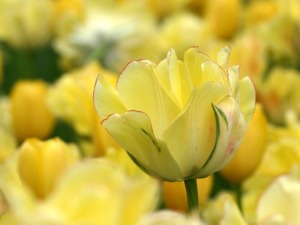Forcing Bulbs

Forcing bulbs is easy, but it does require some planning in advance. Any spring-flowering bulb can be forced, but some are easier than others. Hyacinths and daffodils are the easiest bulbs to force; however, tulips, crocus, grape hyacinth, and snowdrops can also work well. Bulbs can be planted in pots and chilled or forced in water, but both methods require a chilling period before growing (except Paperwhites, but more on that later). When purchasing bulbs, look for large, firm bulbs without blemishes or damage.
Most bulbs will need to be planted in potting soil, with the exception of hyacinths, which can be forced in just water. When planting in pots, use 4-8” pots; azalea style works best, but any pot and potting soil (not garden soil) will work. Add enough soil mixture to fill the pot so bulbs are placed as follows:
- Hyacinths and tulips: Allow only the tip of the bulb to show above the soil line.
- Daffodils: Plant so that about half the bulb shows above the soil line.
- Small bulbs (crocus, snowdrop, grape hyacinth, etc.): Plant so they will be about one inch below the soil line.
Set the bulbs in the pot. One large bulb may be placed in each 4-inch pot. Use six tulips, three hyacinths, five daffodils, or 15 crocus (or another small bulb) in each 6-inch pot. All bulbs in a pot should be of the same kind and variety to ensure uniform flowering. Place tulips with the flattened side of the bulb toward the outside of the pot. The first drooping leaf of tulips comes from the flattened side and will then drape over the edge of the pot instead of into the pot. Fill around the bulbs with potting medium to the proper height. Firm the medium with light pressure, but avoid tight packing. After planting, the final potting medium line should be about 1/4 to 1/2 inch below the rim of the pot. Water the bulbs in.
After potting, keep the bulbs between 35-45 degrees, with about 40 degrees F being ideal. An unheated garage, refrigerator, cellar, or cold frame can keep your potted bulbs in. If bulbs are kept outdoors, they should get adequate moisture to keep them growing, but if you keep bulbs inside, be sure to water them so the soil stays damp. Roots should develop soon after potting; excellent root growth is essential to good growth and flower formation. Potted bulbs should be placed outdoors at least three weeks before the first hard freeze is expected. This is an essential period for good root development.
A few varieties may be brought indoors after about 12 weeks of cooling, but most will require 13 or 14 weeks to develop the necessary roots and top growth. Indoor forcing takes 3 to 4 weeks. Remove potted bulbs from storage at weekly intervals to extend the bloom period. If the potting medium and tops are frozen when the plants are brought indoors, place them in a cool room (about 40 degrees F) for 2 or 3 days to thaw them out slowly. Please don’t touch the plant tops when they are frozen. If plants are not frozen, bring them directly to a cool, bright window where temperatures range close to 60 degrees F; don’t place them in direct sunlight. Keep bulbs watered, but fertilizer won’t be needed.
When flower buds are almost fully developed, bring bulbs into a location where you can enjoy them. Keep the bulbs out of direct sunlight, and if possible, provide cooler nights to prolong the bloom time. Unfortunately, bulbs that have been forced usually don’t transition to being planted outside well and should be discarded.

Have questions? Contact our office where our Horticulture Extension Agent will assist you with questions.
Phone: (316) 321-9660
Email: callae@ksu.edu